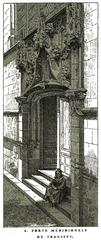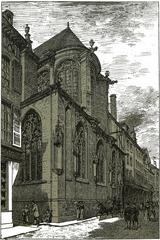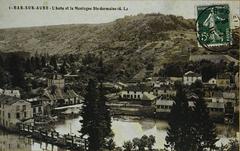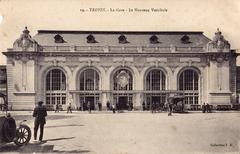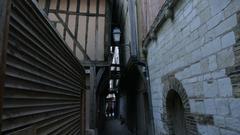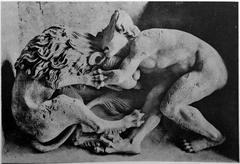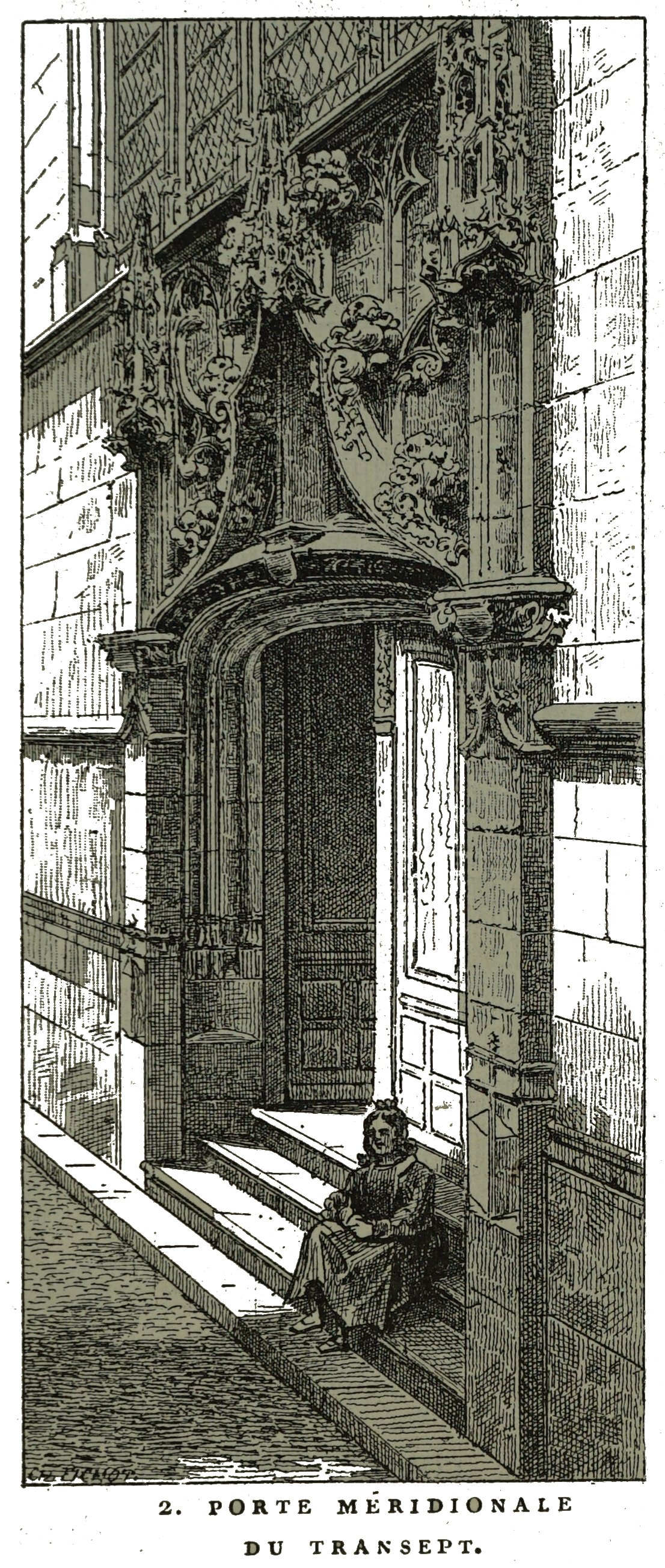
Visiting Église Saint-Pantaléon in Troyes: History, Tickets, and Tips
Date: 01/08/2024
Introduction
Église Saint-Pantaléon, located in the picturesque city of Troyes, France, is a remarkable edifice that encapsulates centuries of history, architectural evolution, and artistic splendor. This church is not only an outstanding example of Renaissance architecture but also a living museum of religious statuary from the Champagne region. Originally built in the 12th century, Église Saint-Pantaléon has undergone numerous transformations and restorations, each layer adding to its rich tapestry of historical significance (Wikipedia). The church’s cruciform layout, barrel-vaulted wooden ceiling, and intricate stained glass windows are a testament to the advanced techniques and artistic vision of the Renaissance era (sacredarchitecture.org). Furthermore, the church’s collection of polychrome statues and stained glass works offer an unparalleled glimpse into the religious and cultural history of the region (Templars Route). This comprehensive guide aims to provide you with essential information on the church’s history, architectural and artistic significance, and practical tips for visiting, ensuring that your experience at Église Saint-Pantaléon is both enriching and unforgettable.
Table of Contents
Historical Background
Early Foundations and Medieval Beginnings
The site of Église Saint-Pantaléon has a rich history that dates back to the 12th century. Initially, it is believed that a synagogue occupied the location, which was later replaced by a wooden church dedicated to Saint Pantaléon in 1189 (Templars Route). Saint Pantaléon, a martyr whose hands were nailed to his head in Rome in 304, became the church’s patron saint. This early wooden structure was a dependency of the nearby Saint-Jean-au-Marché church and served the local community until the early 16th century (Wikipedia).
Renaissance Reconstruction and Devastation
By the early 16th century, the increasing population and the wealth of the local bourgeoisie necessitated a larger, more permanent structure. In 1508, construction began on a new stone church on land belonging to the Vauluisant monks (Anecdotrip). However, a catastrophic fire in 1524 devastated much of Troyes, including the newly constructed Saint-Pantaléon. An inscription on the church’s chevet poignantly notes, “Half of the city was burnt on Saint Urbain’s day. Seven churches burnt, Saint-Pantaléon included. Christian people, gave us money to re-raise this building” (Anecdotrip).
Rebuilding and Expansion
Following the fire, reconstruction efforts were swift. By 1527, additional land was annexed to accommodate a larger church. The lower parts of the church were covered by a temporary roof in 1570, and the upper sections were completed a century later (Templars Route). The church’s exterior was further enhanced around 1740 with the addition of a span and a classic façade, featuring a portal with two superimposed pediments and an octagonal steeple (Patrimoine Histoire).
Architectural Evolution
The architectural style of Église Saint-Pantaléon is predominantly Renaissance, characterized by its cruciform layout and barrel-vaulted wooden ceiling. The west façade, added in the 18th century, complements the church’s overall aesthetic (Lonely Planet). The interior is notable for its narrow nave, which creates a sensation of elevation, and the surrounding balcony and large bay windows enhance the sense of space and light (Templars Route).
Post-Revolutionary Transformation
The French Revolution brought significant changes to Église Saint-Pantaléon. Many 16th-century sculptures from other religious buildings were relocated to the church, transforming it into a remarkable museum of Champagne religious statuary (Troyes La Champagne). This collection includes masterpieces such as the Saint Jacques by Dominique Le Florentin and the Sainte Barbe, both exemplary works of the Troyes School of sculpture (Templars Route).
Notable Artworks and Stained Glass
The church houses an impressive array of polychrome statues and historiated stained glass windows from the 16th century. Among the notable stained glass works are the “Histoire de Daniel” and “La Passion,” attributed to Jehan I Macardré (Templars Route). The stained glass windows, often in grisaille, form a remarkable ensemble that reflects the artistic transition during the Renaissance period.
Restoration and Preservation
Throughout its history, Église Saint-Pantaléon has undergone numerous restorations to preserve its architectural and artistic heritage. The church’s wooden barrel vault, constructed between 1660 and 1675, remains a significant feature. The façade, completed in the early 18th century, showcases the classical style that was prevalent during that period (Patrimoine Histoire).
Visitor Information
Visiting Hours and Ticket Prices
Église Saint-Pantaléon is open to visitors throughout the year. Typical visiting hours are from 9 AM to 6 PM, but it’s advisable to check the official website or contact the church directly for any changes in schedule or special events. Admission is generally free, but donations are welcome to support ongoing preservation efforts.
Travel Tips
The best time to visit Église Saint-Pantaléon is during the spring and summer months when the weather is pleasant. Troyes is well-connected by train and bus, and the church is easily accessible on foot from the city center. For those driving, parking is available nearby.
Nearby Attractions
While visiting Église Saint-Pantaléon, consider exploring other historical sites in Troyes, such as the Troyes Cathedral, the Museum of Modern Art, and the half-timbered houses in the old town. These attractions provide a deeper insight into the rich cultural heritage of the city.
Accessibility
Église Saint-Pantaléon is committed to being accessible to all visitors. The church is equipped with ramps and facilities to accommodate wheelchair users. Bathroom facilities and seating areas are also available for visitors’ convenience.
Special Events and Guided Tours
The church frequently hosts special events, including concerts and art exhibitions. Guided tours are available and offer an in-depth look at the church’s history, architecture, and art collections. Photography is allowed, making it an ideal spot for capturing the beauty of Renaissance architecture and stained glass windows.
Conclusion
Église Saint-Pantaléon is not just a place of worship but a testament to the resilience and artistic heritage of Troyes. Its historical and architectural significance, combined with its rich collection of artworks, makes it a must-visit destination in Troyes. By understanding the historical background and practical visiting tips, visitors can appreciate the depth of its heritage and the efforts made to preserve its legacy for future generations.
FAQ
Q: What are the visiting hours for Église Saint-Pantaléon? A: The church is typically open from 9 AM to 6 PM, but it’s best to check the official website for any changes.
Q: Is there an admission fee to visit Église Saint-Pantaléon? A: Admission is generally free, but donations are welcome.
Q: Are there guided tours available? A: Yes, guided tours are available and offer detailed insights into the church’s history and art.
Q: Is Église Saint-Pantaléon accessible for wheelchair users? A: Yes, the church is equipped with ramps and other facilities to accommodate wheelchair users.
Q: What other attractions are nearby? A: Nearby attractions include the Troyes Cathedral, the Museum of Modern Art, and the old town’s half-timbered houses.
Call to Action
Don’t miss the chance to explore Église Saint-Pantaléon and its rich heritage. For more travel tips and updates, download our mobile app Audiala, check out our other related posts, or follow us on social media.
References
- Templars Route. (n.d.). Église Saint-Pantaléon. Retrieved from Templars Route
- Wikipedia. (n.d.). Église Saint-Pantaléon de Troyes. Retrieved from Wikipedia
- Anecdotrip. (n.d.). A Little History of Saint-Pantaleon Church in Troyes. Retrieved from Anecdotrip
- Patrimoine Histoire. (n.d.). Troyes: Saint-Pantaleon. Retrieved from Patrimoine Histoire
- Lonely Planet. (n.d.). Église St-Pantaléon. Retrieved from Lonely Planet
- sacredarchitecture.org. (n.d.). Renaissance Churches of Troyes and Their Stained Glass. Retrieved from sacredarchitecture.org
- Troyes La Champagne. (n.d.). Église Saint-Pantaléon. Retrieved from Troyes La Champagne
